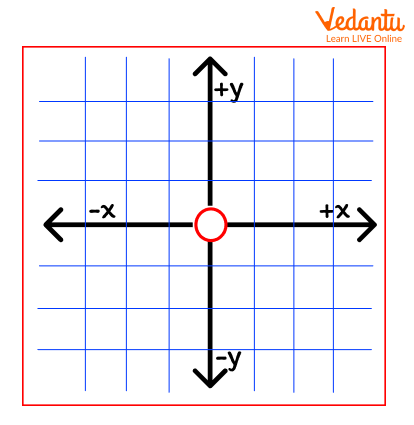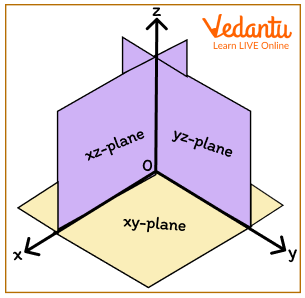




The word ‘origin’ means source or beginning. In Maths, however, it is marked as the intersection point of the axes of a coordinate system. The term ‘origin’ has a great significance in Maths and it is practically indispensable in geometry and trigonometry. Many theorems are based on the origin and there are several practical uses of the concept of origin in real life as well. Let us learn more about this term.
Definition of Origin
In Mathematics, the origin can be defined as the point of intersection of the coordinate axes. It is the point where the coordinates are zero.
Origin in Two Dimensions
If we consider a flat coordinate plane, then we can find two axes, one is the y-axis, which is vertical, and the other is the x-axis, which is horizontal. The origin is the point of intersection of these two axes. This origin point has coordinates (0,0) and it is generally labelled as O.

Origin in a two-dimensional surface
Origin in Three Dimensions
When we consider a three-dimensional or 3D coordinate system, there is a third axis, called the z-axis, in addition to the horizontal x-axis and the vertical y-axis. This z-axis can be considered coming in and going out of the screen at right angles to the two other axes (x-axis and y-axis). The origin is again named as point O, and all the three axes intersect at this origin. This point has coordinates (0,0,0).

Origin in a three-dimensional surface
Practical Uses of Origin
The origin is definitely an important instrument in Maths, but it is also full of practical uses in daily life. Some of the ways the origin can be used in real life are as follows:
Navigating Maps − While navigating maps to reach a point, we need a point to refer to, which should be kept constant. This point will be our origin. This can be our current location or even a safehouse on the way. We will then be able to measure the distances and directions from this point of origin to locate exact places and reach them.
Constructing Buildings and Structures − While constructing buildings and structures, a point of origin is a must so that proper measures can be taken and there is no miscalculation in the placement of bricks and beams throughout the structure. Improper measurements of such points from the origin can cause the building to topple.
Launching Missiles or Rockets − The launching of missiles or rockets can be better performed with accurate positioning of the origin. Guided weapons like torpedos use the concept of origin to mark targets.
Locating Tsunamis − Tsunamis originate in certain zones in the oceans, and to accurately determine the time and distance between intervals and areas, the concept of origin is used by seismologists.
Navigation in Dolphins and Bats − Animals like dolphins and bats use sonic waves to navigate, and as the waves originate from them, they can almost accurately measure what’s in their way.
Conclusion
The concept of ‘origin’ is extremely important in Mathematics and it should be well understood and internalised as it comes in handy in real life as well. A lot of calculations depend on this concept and it is simply indispensable in finding accuracy in measurements.
FAQs on Meaning of Origin in Maths − Why is it Important?
1. Why is the concept of origin important to learn?
The concept of origin is used to accurately measure lines and points on the coordinate planes, and such measurements are heavily used in trigonometry and geometry. Learning this concept well will give you an edge when it comes to constructions and related theorems.
2. What are some of the practical uses of the concept of origin?
The concept of origin helps in the navigation of maps, the construction of buildings and structures, launching of missiles and rockets, locating tsunamis, navigation in animals like dolphins and bats, etc.











